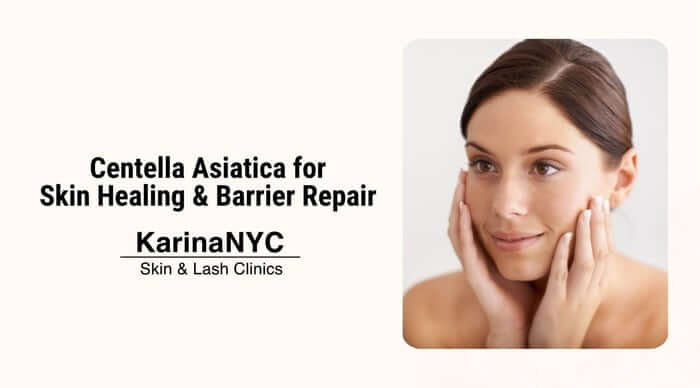Yes, lactic acid is safe for sensitive skin when used correctly. Its large molecule size makes it gentler than other acids, and it hydrates while exfoliating. Start with low percentages, patch test, and use SPF to avoid irritation or sensitivity flare-ups.
If you’ve been struggling with texture, dullness, or stubborn flakes, but every “glow” product burns your skin, lactic acid might be the missing link. At KarinaNYC, we’ve seen how this gentle AHA transforms even the most reactive skin types when used with intention.
In this article, you’ll learn exactly how to use lactic acid safely, which myths to ignore, and which French-formulated products actually deliver results, without compromising your barrier.
Let’s walk through the essentials together.
Meet Lactic Acid: The Gentle Giant Of Skincare Acids

When clients ask about exfoliating acids, I almost always start with lactic acid. It’s an AHA derived from milk sugars or fermented plants, and one of the few I trust for sensitive or reactive skin.
Unlike glycolic acid, which dives deep and can overwhelm, lactic acid works on the surface, gently dissolving dead skin cells without triggering that dreaded sting. Its larger molecule size means slower absorption and less irritation, making it the perfect starter acid for anyone with a delicate barrier.
What makes it even more special? Your skin already “knows” it.
Lactic acid is a natural component of the skin’s own moisturizing system (NMFs), which is why it hydrates while it exfoliates. This dual action is rare. With regular use, it smooths texture, boosts radiance, and supports the skin’s natural defenses, no redness, no stripping, just real, lasting results.
Glow Gently: What Lactic Acid Can Do For Sensitive Skin
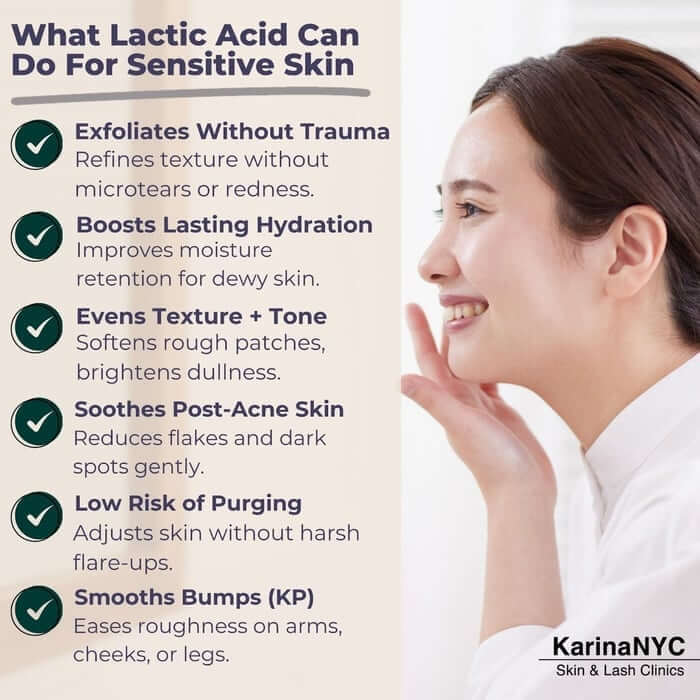
When used properly, lactic acid can completely change the way sensitive skin behaves. Here’s how I’ve seen it help both my clients and my own skin over the years:
- Gentle exfoliation without trauma: It refines texture and lifts away buildup without the microtears or redness caused by physical scrubs.
- Hydration that lasts: It naturally increases the skin’s ability to hold water, giving that fresh, dewy glow even when skin feels dry or tight.
- Smoother tone and texture: Over time, skin looks more even, radiant, and resilient, without the harsh peeling phase.
- Post-acne and flakiness relief: When combined with barrier-loving ingredients, it can calm the look of dark spots or rough patches left behind by breakouts.
- Less chance of purging: It’s gentler than glycolic or salicylic acid, so while a mild adjustment phase can happen, full-blown purging is rare.
- Improves keratosis pilaris and bumpiness: A consistent low-strength formula can smooth out the tiny, rough spots on arms or cheeks that so many of my clients struggle with.
Sensitive skin doesn’t need to avoid exfoliation, it just needs the right kind. And lactic acid, when introduced thoughtfully, can be the bridge between dull, reactive skin and calm, glowing radiance.
Avoid The Burn: Smart Rules For Starting Lactic Acid
Sensitive skin needs leadership, not guesswork. That means taking the time to understand how, when, and if you introduce certain ingredients.
And with lactic acid? It’s not about going in strong, it’s about going in smart.
Patch Testing Is Non-Negotiable.
Even if the formula says “gentle,” your skin decides what’s gentle. I always recommend dabbing a small amount behind the ear or on the jawline and waiting 24–48 hours before applying it to your full face.
Sensitive skin can be unpredictable, better to be cautious than reactive.
Start Slow, Then Watch How Your Skin Responds.
Once per week is plenty when you’re just beginning. If your skin feels balanced (no tightness, peeling, or lingering redness), you can gradually increase to 2–3 times weekly.
Remember: consistency beats intensity every single time.
Nighttime Is Best, Always Follow With Moisturizer, And Use SPF The Next Day.
Lactic acid makes your skin more vulnerable to UV, even in cloudy weather. I use it at night, followed by a barrier-focused moisturizer like Crème Masque Vernix or Serum Colostrum VG.
Come morning, sunscreen is not optional, it’s mandatory.
Don’t Mix It With Retinol, Benzoyl Peroxide, Or High-Dose Vitamin C.
This is where so many people get tripped up. Layering active ingredients seems efficient, but it often leads to over-exfoliation and barrier breakdown. I coach my clients to alternate, retinol one night, lactic acid another, never together.
Know The Red Flags.
A little tingle is normal, especially the first time. But if your skin turns red, hot, or irritated for more than 10 minutes, that’s not “working”, that's a warning. Take it seriously and dial it back.
Sensitive But Want to Glow? Start with These 5 BR Staples
Masque Visolastine+

If your skin is both sensitive and dry, this is where to start. Masque Visolastine is infused with lactic acid and hyaluronic acid to gently hydrate, soften, and improve elasticity, without any sting or tightness.
It’s ideal for skin instants that need moisture and barrier support more than detox.
Lotion P50W
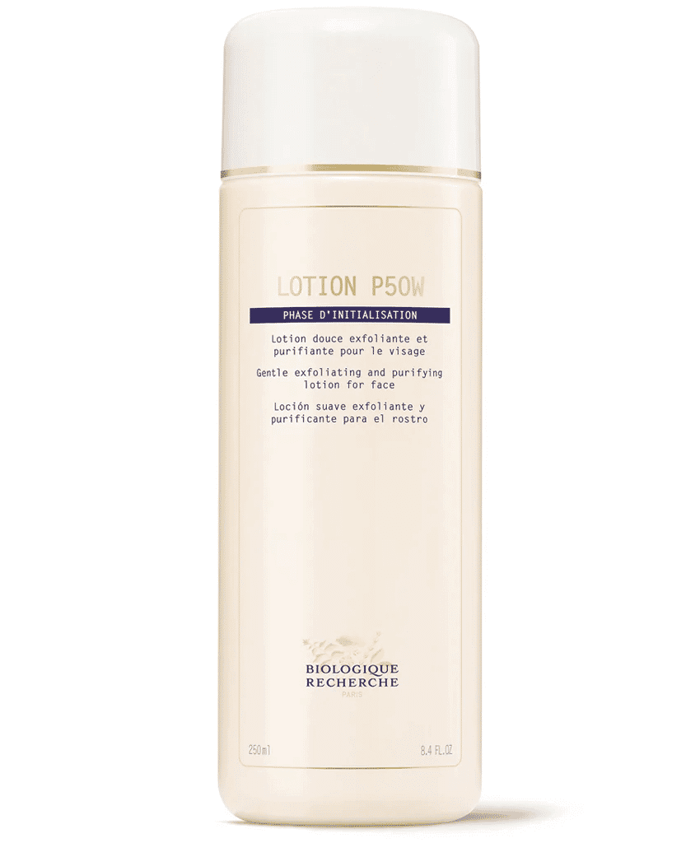
The gentlest P50 version, specifically formulated without phenol and includes calming arnica. Contains lactic acid at a safe percentage for gradual exfoliation.
Masque Biosensible
Ideal for rosacea or compromised skin. While not a direct lactic acid treatment, it works beautifully in tandem with lactic acid to calm and hydrate post-application.
Masque VIP O2

A soothing, oxygenating mask that pairs well with lactic acid products. Perfect for layering after exfoliation to protect against urban pollution and skin fatigue.
Crème Masque Vernix
For skin in healing mode. Use this to buffer after lactic acid nights, especially when you're worried about flare-ups or dryness. Replenishes and repairs.
From Confused to Confident: Your Top Lactic Acid Questions
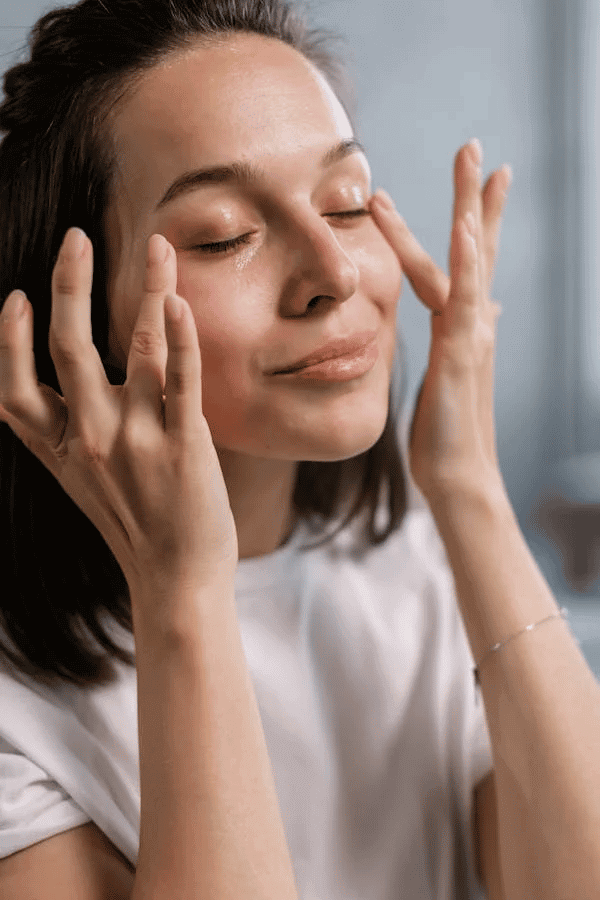
These are the exact questions I get every week from clients walking into KarinaNYC with a bottle of acid and a lot of confusion.
So let’s clear the air, because the right knowledge is what turns uncertainty into confidence.
How Long Does It Take To See Results?
With lactic acid, we’re playing the long game, and that’s the beauty of it. You can expect to notice smoother, more radiant skin in 2 to 4 weeks, especially in texture and tone.
This isn’t a “burn and peel” situation. It’s slow, steady progress that honors your skin’s sensitivity and rhythm.
What Percentage Should I Use?
If you're new to acids or have reactive skin, stick with 5% or lower to start. That’s the sweet spot, enough to get results without stressing the skin.
Only consider moving up to 8–10% once your skin shows it can handle the lower strength consistently, and always with the right support products.
Can I Use It Every Day?
Not if your skin is sensitive. Consistency matters more than frequency. Two to three nights a week is more than enough to get cumulative results without risking barrier damage. If your skin starts feeling dry, tight, or overly “thin,” back off immediately and go back to your repair phase.
Why Does It Sting Now But Didn’t Before?
Several culprits: layering it with other actives, overuse, seasonal dehydration, or a compromised moisture barrier. I’ve seen this time and time again with clients who layer too much too fast.
My advice? Simplify. Go back to basics for a few nights, nourish, repair, and then reintroduce lactic acid gradually.
Is It Going To Thin My Barrier?
If you overdo it, yes. But when used thoughtfully and paired with nourishing products, lactic acid can support a stronger, healthier skin barrier over time. That’s exactly what we see with our clients at KarinaNYC.
Sensitive Skin? Let’s Build Your Glow Plan Together
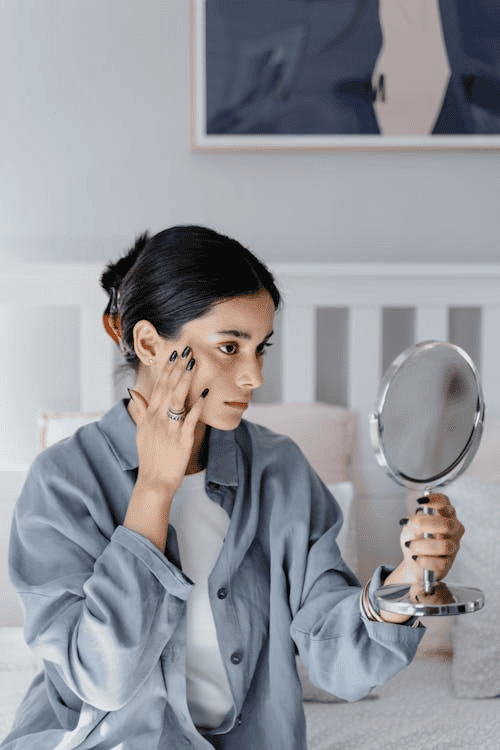
If you’re someone who’s invested in your skin, but exhausted by products that overpromise, underdeliver, or worse, irritate, you’re not alone.
At KarinaNYC, we see this every day. The problem isn’t you. It’s the lack of guidance.
Sensitive skin doesn’t need to avoid exfoliation. It just needs smarter support. When introduced at the right time, in the right way, lactic acid can gently renew your skin, soften stubborn texture, and bring back a glow you haven’t seen in years, without triggering a flare-up. That’s what we specialize in.
Whether you’re navigating post-acne marks, dullness, or early signs of aging, here’s how we can help you ease into lactic acid the right way:
🌿 Free Skin Consultation: Not sure which product (or percentage) is right for you? Our expert team will assess your skin’s history, current routine, and sensitivity level to match you with a customized plan, no guessing, no overwhelm.
💧 Masque Vivant + VIP O2 Combo: This duo is our gentle powerhouse. Masque Vivant clears congestion and resurfaces the skin, while VIP O2 brings in oxygen, hydration, and calm. Ideal for first-timers or anyone afraid of overdoing it.
🧴 Barrier Recovery Routine: If your skin is easily irritated, we start here. Our 3-step protocol supports the skin’s natural defenses while prepping it to tolerate gentle actives like lactic acid. Repair first, then treat.
This is your sign to stop treating your skin like a science experiment. Let us help you build a plan that’s as thoughtful and intelligent as you are.
Because the right products, in the right hands, can do so much more than make your skin glow, they can give you your confidence back.

